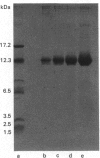Abstract
The complete amino acid sequence of cytochrome c from the nematode Caenorhabditis elegans was determined. The native protein displays the same spectral properties in the oxidized and reduced states as horse heart cytochrome c. The apoprotein consists of 110 amino acid residues and differs from human cytochrome c by 44 substitutions, one internal deletion, five N-terminal additions and two C-terminal additions. One of the substitutions is the replacement of an 'invariant' phenylalanine residue at position 15 by tyrosine. The N-terminal sequence extension contains a short peptide motif, which is highly homologous with a peptide fragment present at the N-terminus of annelid and insect cytochrome c sequences. From the number of amino acid changes and the evolutionary rate of cytochrome c it would appear that nematodes diverged from a line leading to man about 1.4 billion years ago. When similar data based on the amino acid sequences of the histones H1, H2A, H2B and H3 are taken into account, the average estimate is 1.1 +/- 0.1 billion years.
Full text
PDF







Images in this article
Selected References
These references are in PubMed. This may not be the complete list of references from this article.
- AMBLER R. P. THE AMINO ACID SEQUENCE OF PSEUDOMONAS CYTOCHROME C-551. Biochem J. 1963 Nov;89:349–378. doi: 10.1042/bj0890349. [DOI] [PMC free article] [PubMed] [Google Scholar]
- Dickerson R. E. The structures of cytochrome c and the rates of molecular evolution. J Mol Evol. 1971;1(1):26–45. doi: 10.1007/BF01659392. [DOI] [PubMed] [Google Scholar]
- Evenberg A., Meyer H., Gaastra W., Verheij H. M., De Haas G. H. Amino acid sequence of phospholipase A2 from horse pancreas. J Biol Chem. 1977 Feb 25;252(4):1189–1196. [PubMed] [Google Scholar]
- Houmard J., Drapeau G. R. Staphylococcal protease: a proteolytic enzyme specific for glutamoyl bonds. Proc Natl Acad Sci U S A. 1972 Dec;69(12):3506–3509. doi: 10.1073/pnas.69.12.3506. [DOI] [PMC free article] [PubMed] [Google Scholar]
- Inglis A. S. Cleavage at aspartic acid. Methods Enzymol. 1983;91:324–332. doi: 10.1016/s0076-6879(83)91030-3. [DOI] [PubMed] [Google Scholar]
- Laemmli U. K. Cleavage of structural proteins during the assembly of the head of bacteriophage T4. Nature. 1970 Aug 15;227(5259):680–685. doi: 10.1038/227680a0. [DOI] [PubMed] [Google Scholar]
- Lyddiatt A., Peacock D., Boulter D. Evolutionary change in invertebrate cytochrome C. J Mol Evol. 1978 May 12;11(1):35–45. doi: 10.1007/BF01768023. [DOI] [PubMed] [Google Scholar]
- MARGOLIASH E., FROHWIRT N. Spectrum of horse-heart cytochrome c. Biochem J. 1959 Mar;71(3):570–572. doi: 10.1042/bj0710570. [DOI] [PMC free article] [PubMed] [Google Scholar]
- MARGOLIASH E. PRIMARY STRUCTURE AND EVOLUTION OF CYTOCHROME C. Proc Natl Acad Sci U S A. 1963 Oct;50:672–679. doi: 10.1073/pnas.50.4.672. [DOI] [PMC free article] [PubMed] [Google Scholar]
- MATSUBARA H., SMITH E. L. HUMAN HEART CYTOCHROME C. CHYMOTRYPTIC PEPTIDES, TRYPTIC PEPTIDES, AND THE COMPLETE AMINO ACID SEQUENCE. J Biol Chem. 1963 Aug;238:2732–2753. [PubMed] [Google Scholar]
- Roepstorff P., Fohlman J. Proposal for a common nomenclature for sequence ions in mass spectra of peptides. Biomed Mass Spectrom. 1984 Nov;11(11):601–601. doi: 10.1002/bms.1200111109. [DOI] [PubMed] [Google Scholar]
- Salemme F. R. Structure and function of cytochromes c. Annu Rev Biochem. 1977;46:299–329. doi: 10.1146/annurev.bi.46.070177.001503. [DOI] [PubMed] [Google Scholar]
- Schägger H., von Jagow G. Tricine-sodium dodecyl sulfate-polyacrylamide gel electrophoresis for the separation of proteins in the range from 1 to 100 kDa. Anal Biochem. 1987 Nov 1;166(2):368–379. doi: 10.1016/0003-2697(87)90587-2. [DOI] [PubMed] [Google Scholar]
- Vanfleteren J. R., Van Bun S. M., De Baere I., Van Beeumen J. J. The primary structure of a minor isoform (H1.2) of histone H1 from the nematode Caenorhabditis elegans. Biochem J. 1990 Feb 1;265(3):739–746. doi: 10.1042/bj2650739. [DOI] [PMC free article] [PubMed] [Google Scholar]
- Vanfleteren J. R., Van Bun S. M., Delcambe L. L., Van Beeumen J. J. Multiple forms of histone H2B from the nematode Caenorhabditis elegans. Biochem J. 1986 May 1;235(3):769–773. doi: 10.1042/bj2350769. [DOI] [PMC free article] [PubMed] [Google Scholar]
- Vanfleteren J. R., Van Bun S. M., Van Beeumen J. J. The primary structure of histone H2A from the nematode Caenorhabditis elegans. Biochem J. 1987 Apr 1;243(1):297–300. doi: 10.1042/bj2430297. [DOI] [PMC free article] [PubMed] [Google Scholar]
- Vanfleteren J. R., Van Bun S. M., Van Beeumen J. J. The primary structure of histone H3 from the nematode Caenorhabditis elegans. FEBS Lett. 1987 Jan 19;211(1):59–63. doi: 10.1016/0014-5793(87)81274-7. [DOI] [PubMed] [Google Scholar]
- Vanfleteren J. R., Van Bun S. M., Van Beeumen J. J. The primary structure of histone H4 from the nematode Caenorhabditis elegans. Comp Biochem Physiol B. 1987;87(4):847–849. doi: 10.1016/0305-0491(87)90400-7. [DOI] [PubMed] [Google Scholar]
- Vanfleteren J. R., Van Bun S. M., Van Beeumen J. J. The primary structure of the major isoform (H1.1) of histone H1 from the nematode Caenorhabditis elegans. Biochem J. 1988 Oct 15;255(2):647–652. [PMC free article] [PubMed] [Google Scholar]
- Walker J. M., Hastings J. R., Johns E. W. The primary structure of a non-histone chromosomal protein. Eur J Biochem. 1977 Jun 15;76(2):461–468. doi: 10.1111/j.1432-1033.1977.tb11616.x. [DOI] [PubMed] [Google Scholar]
- Wilson A. C., Carlson S. S., White T. J. Biochemical evolution. Annu Rev Biochem. 1977;46:573–639. doi: 10.1146/annurev.bi.46.070177.003041. [DOI] [PubMed] [Google Scholar]



